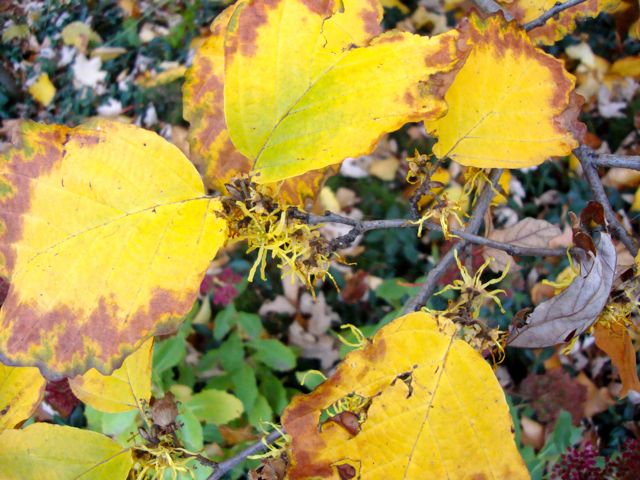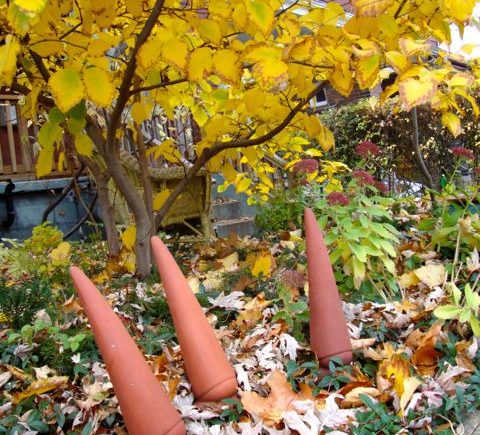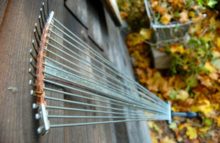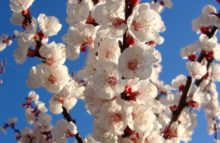| Guess which witch caught my eye while walking? |
Are they witches’ caps or gnomes? Whatever they are, they called to me (and my ever-present camera) from the shrubbery as I power-walked through our neighbourhood at 7:30 this morning
.
Not till I started to move again did I realize which witch was witch-hazel… in this case, the native Hamamelis virginiana shrub making with the golden leaves and flowers above.
 |
| Hamamelis virginiana‘s threadlike blooms appear in autumn |
H. virginiana
blooms in fall, unlike the Asian witch-hazel hybrids I wrote about in March 2009. Those flowers appear before the leaves, making them quite showy, especially early in the year. The native shrub is much more soft-spoken. That’s why I almost missed the flowers, hidden between leaves of a similar hue.
Interestingly, witch-hazel is neither witchy nor a hazel. “Witch” derives from the Old English “wych” referring to the pliable branches, sometimes used as “witching rods” for divining water, which is a kind of witchery in itself, I suppose. “Hazel” refers to the similarity of the leaf shape to the hazelnut or Corylus, which in fact is unrelated or very distantly so. (I had to look it up: They both belong to the Eudicot clade of Angiosperms. I know, you were just abou
t to say that.) Instead, Hamamelis is a cousin of Fothergilla, another native shrub with wispy petals and great fall colour.
For more re
ading on witch hazel, you might enjoy this excellent article by Steven Foster or the useful pictures on Walter Muma’s Ontario Trees and Shrubs. And when you’re walking through your neighbourhood, keep your eyes open. You might catch this native shrub casting its gentle autumn spell.





11 comments
So what on earth are those cones? They certainly are eyecatchers! Unfortunately witchhazel doesn't grow well in our area. It has beautiful autumn colour as demonstrated here.
Shirley, they're a little huddle of faceless humanoids with tall, pointy hats. Elves? Gnomes? Mini-witches? Your guess is as good as mine.
Incidentally, I once saw a slogan painted on a railway bridge, likely written by Elvis fans with a spelling dysfunction. It read: Elves Forever!
Ah, one of my favourite natives, that Hamamelis. Those golden leaves just glow, don't they. But the gnome-hats? I love them. I could see putting THOSE in my garden, where I'm a confirmed gnome-hater most of the time. They appeal to my sense of humour, bigtime.
Interesante…
I've never seen a H. virginiana in autumn, but the colour is stunning. It's a pity the flowers are so hidden away. If you're interested, here's a piece I wrote about witch hazels a while back http://tinyurl.com/34r7mnn
I just planted this, this past early spring. I can't wait to watch it grow. Those "witch hats" certainly are an eye-stopper.
Thanks, Jodi, in addition to the exaggerated hats, I think it's the simplicity of the features that work here.
Martyn, Thanks for the link, which mentions growing conditions and a number of select cultivars. I'd love the room for a collection of 60… of anything!
Violet Fern, Good luck with your shrub. Is it the spring blooming or the fall blooming variety?
Wendy, The blooming on this particular specimen was quite modest. But often the blooms will persist after the leaves fall, making for a better show. The newer hybrids are bred for showiness, though.
I should also mention that the winter/spring-blooming native witch-hazel (Hamamelis vernalis) is particularly fragrant. There wasn't any obvious perfume when I sniffed this one, however.
I love the native hamamelis! I have several in my garden and love their spidery blooms~The pointy elvish/gnomish cones are certainly puzzling! gail
About witches . . .
When we moved into our house in the country, when I was fourteen, there were still builders doing . . . don't know what . . .
There were two substantial rows of cob nut bushes in the garden and one of the builders showed me how to use a V shape twig to divine . . . what. . .?
I thought he was teasing me when I saw the twig swing round but was surprised by its force when I tried it myself. Indeed, if I tried to stop it swinging, it twisted the bark.
Traditionally, here, divining rods are used for finding water but the twigs from this bush weren't interested in water because they didn't move if we held them over the well but there was a particular point in the orchard where the reaction was un-missable and strong.
After a while, it stopped. I don't know whether it was me losing whatever 'skill' it was or whether whatever was causing the movement dried up, dissolved or went away.
Because of this, I've always thought cob nuts were witch hazel. Now it turns out they aren't.
Another mystery in life!
Esther
Hey – I have one of those gnomes in my garden and so does my neighbour. They were selling them at Ikea so I expect there are many pointy hat gnome owners out there (they are gnomes BTW).
Those certainly are interesting gnomes, if that's the name they go by!